A Critical Analysis of Patient Waiting Times in US Radiology (2020)
VerifiedAdded on 2022/08/15
|13
|2543
|15
Report
AI Summary
This report provides a critical analysis of patient waiting times for radiological procedures in the US healthcare system. It explores the background, rationale, scope, aims, and objectives of addressing this issue. The report delves into the theoretical framework, specifically utilizing queuing theory to understand and predict queue lengths and waiting times. The methodology involves a systematic review of relevant literature, analyzing factors contributing to increased wait times such as staffing issues, inefficient appointment systems, and patient variability. Evidence from various studies is examined to identify root causes and propose solutions, including software for medicine availability, printed prescriptions, and managing patient flow. The report also provides recommendations to effectively reduce patient waiting times and improve overall healthcare service quality and patient satisfaction.
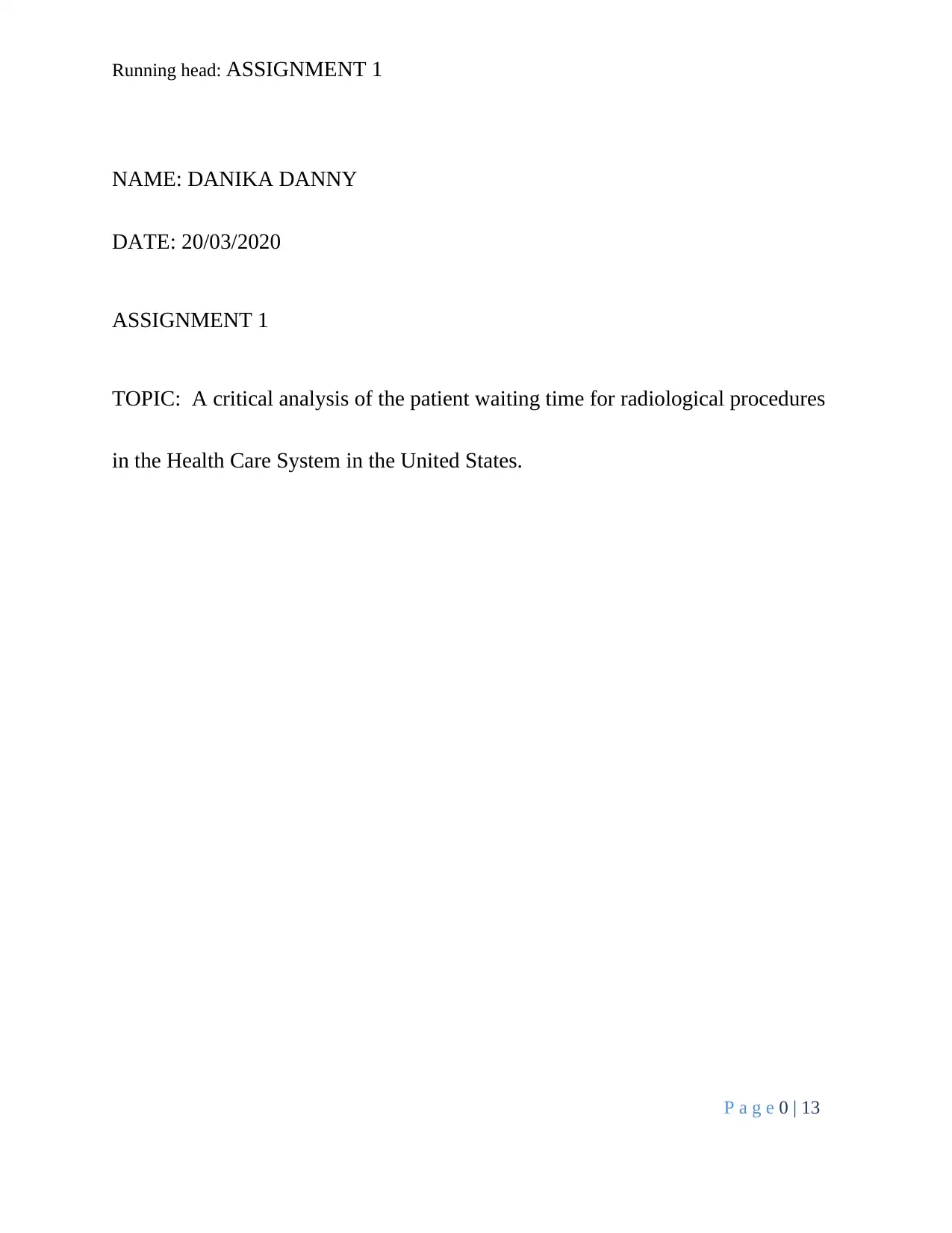
Running head: ASSIGNMENT 1
NAME: DANIKA DANNY
DATE: 20/03/2020
ASSIGNMENT 1
TOPIC: A critical analysis of the patient waiting time for radiological procedures
in the Health Care System in the United States.
P a g e 0 | 13
NAME: DANIKA DANNY
DATE: 20/03/2020
ASSIGNMENT 1
TOPIC: A critical analysis of the patient waiting time for radiological procedures
in the Health Care System in the United States.
P a g e 0 | 13
Paraphrase This Document
Need a fresh take? Get an instant paraphrase of this document with our AI Paraphraser
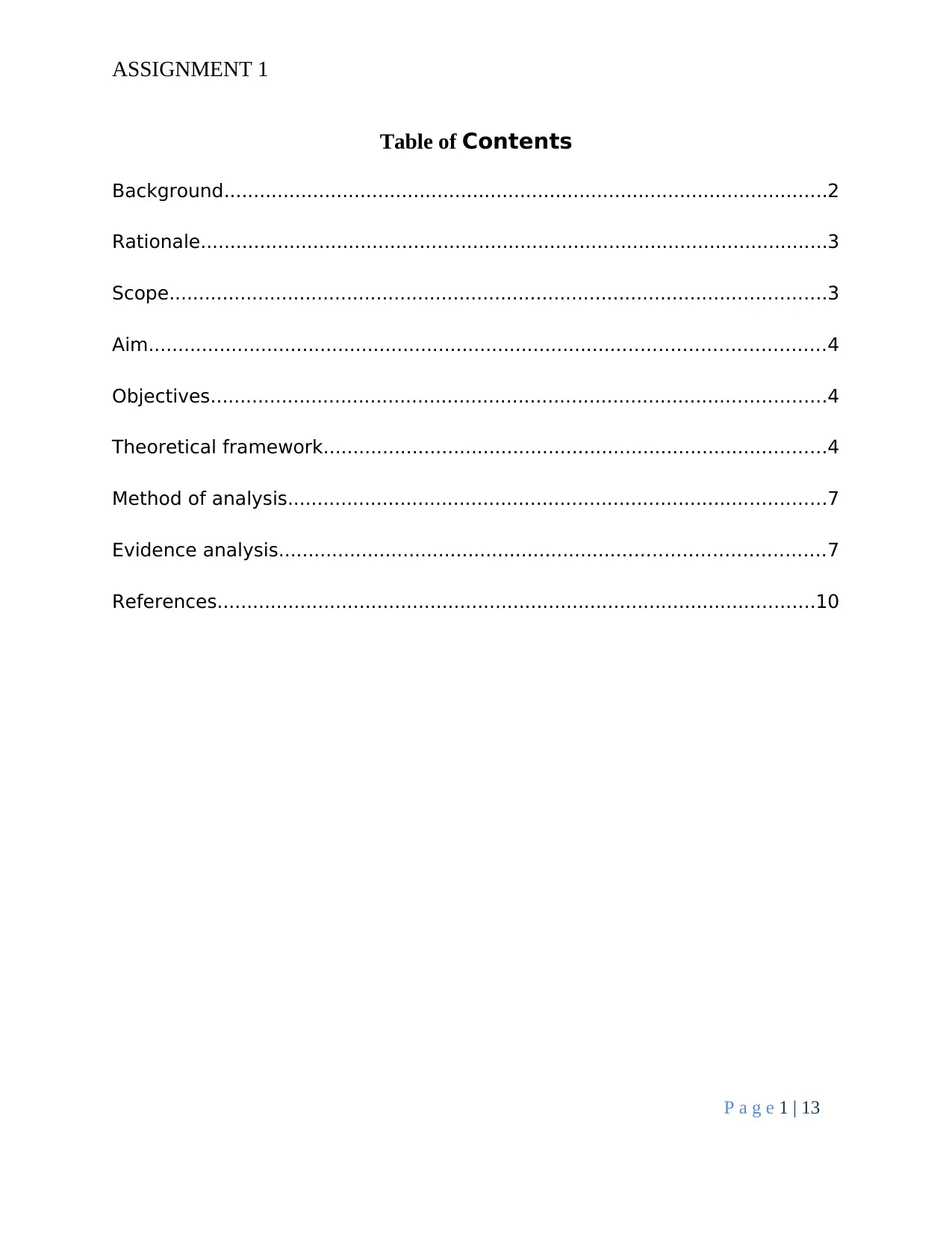
ASSIGNMENT 1
Table of Contents
Background......................................................................................................2
Rationale..........................................................................................................3
Scope...............................................................................................................3
Aim..................................................................................................................4
Objectives........................................................................................................4
Theoretical framework.....................................................................................4
Method of analysis...........................................................................................7
Evidence analysis............................................................................................7
References.....................................................................................................10
P a g e 1 | 13
Table of Contents
Background......................................................................................................2
Rationale..........................................................................................................3
Scope...............................................................................................................3
Aim..................................................................................................................4
Objectives........................................................................................................4
Theoretical framework.....................................................................................4
Method of analysis...........................................................................................7
Evidence analysis............................................................................................7
References.....................................................................................................10
P a g e 1 | 13
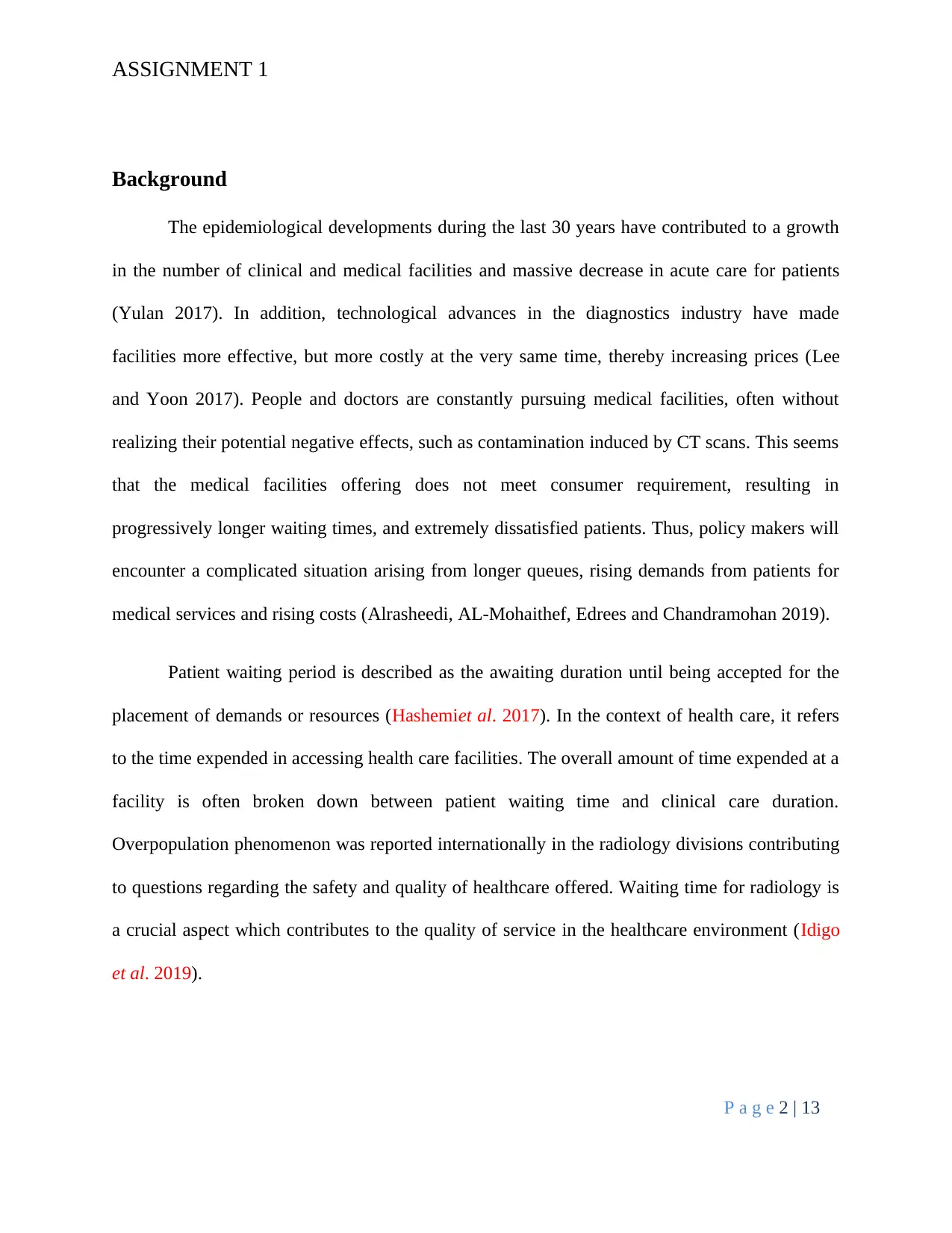
ASSIGNMENT 1
Background
The epidemiological developments during the last 30 years have contributed to a growth
in the number of clinical and medical facilities and massive decrease in acute care for patients
(Yulan 2017). In addition, technological advances in the diagnostics industry have made
facilities more effective, but more costly at the very same time, thereby increasing prices (Lee
and Yoon 2017). People and doctors are constantly pursuing medical facilities, often without
realizing their potential negative effects, such as contamination induced by CT scans. This seems
that the medical facilities offering does not meet consumer requirement, resulting in
progressively longer waiting times, and extremely dissatisfied patients. Thus, policy makers will
encounter a complicated situation arising from longer queues, rising demands from patients for
medical services and rising costs (Alrasheedi, AL-Mohaithef, Edrees and Chandramohan 2019).
Patient waiting period is described as the awaiting duration until being accepted for the
placement of demands or resources (Hashemiet al. 2017). In the context of health care, it refers
to the time expended in accessing health care facilities. The overall amount of time expended at a
facility is often broken down between patient waiting time and clinical care duration.
Overpopulation phenomenon was reported internationally in the radiology divisions contributing
to questions regarding the safety and quality of healthcare offered. Waiting time for radiology is
a crucial aspect which contributes to the quality of service in the healthcare environment (Idigo
et al. 2019).
P a g e 2 | 13
Background
The epidemiological developments during the last 30 years have contributed to a growth
in the number of clinical and medical facilities and massive decrease in acute care for patients
(Yulan 2017). In addition, technological advances in the diagnostics industry have made
facilities more effective, but more costly at the very same time, thereby increasing prices (Lee
and Yoon 2017). People and doctors are constantly pursuing medical facilities, often without
realizing their potential negative effects, such as contamination induced by CT scans. This seems
that the medical facilities offering does not meet consumer requirement, resulting in
progressively longer waiting times, and extremely dissatisfied patients. Thus, policy makers will
encounter a complicated situation arising from longer queues, rising demands from patients for
medical services and rising costs (Alrasheedi, AL-Mohaithef, Edrees and Chandramohan 2019).
Patient waiting period is described as the awaiting duration until being accepted for the
placement of demands or resources (Hashemiet al. 2017). In the context of health care, it refers
to the time expended in accessing health care facilities. The overall amount of time expended at a
facility is often broken down between patient waiting time and clinical care duration.
Overpopulation phenomenon was reported internationally in the radiology divisions contributing
to questions regarding the safety and quality of healthcare offered. Waiting time for radiology is
a crucial aspect which contributes to the quality of service in the healthcare environment (Idigo
et al. 2019).
P a g e 2 | 13
⊘ This is a preview!⊘
Do you want full access?
Subscribe today to unlock all pages.

Trusted by 1+ million students worldwide
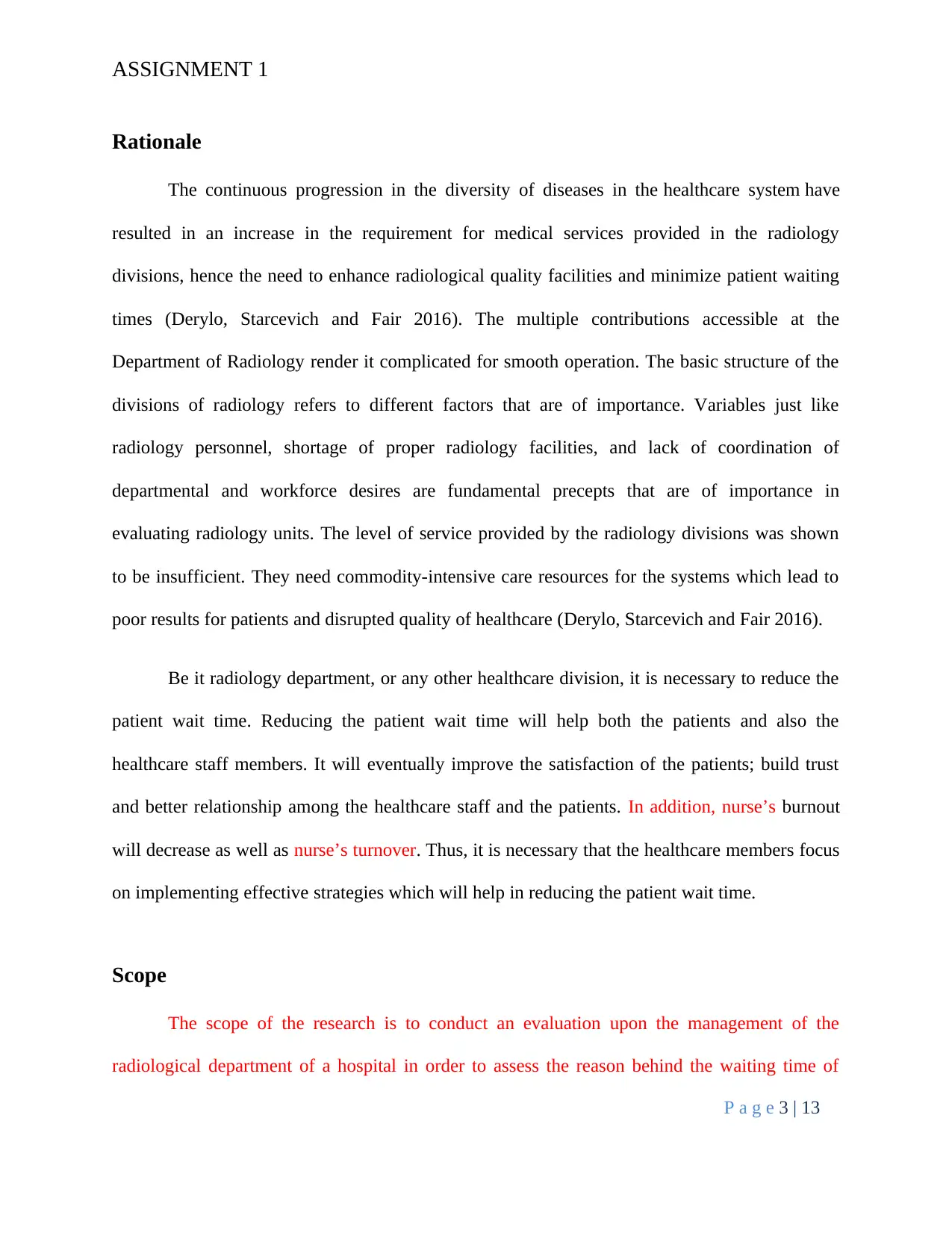
ASSIGNMENT 1
Rationale
The continuous progression in the diversity of diseases in the healthcare system have
resulted in an increase in the requirement for medical services provided in the radiology
divisions, hence the need to enhance radiological quality facilities and minimize patient waiting
times (Derylo, Starcevich and Fair 2016). The multiple contributions accessible at the
Department of Radiology render it complicated for smooth operation. The basic structure of the
divisions of radiology refers to different factors that are of importance. Variables just like
radiology personnel, shortage of proper radiology facilities, and lack of coordination of
departmental and workforce desires are fundamental precepts that are of importance in
evaluating radiology units. The level of service provided by the radiology divisions was shown
to be insufficient. They need commodity-intensive care resources for the systems which lead to
poor results for patients and disrupted quality of healthcare (Derylo, Starcevich and Fair 2016).
Be it radiology department, or any other healthcare division, it is necessary to reduce the
patient wait time. Reducing the patient wait time will help both the patients and also the
healthcare staff members. It will eventually improve the satisfaction of the patients; build trust
and better relationship among the healthcare staff and the patients. In addition, nurse’s burnout
will decrease as well as nurse’s turnover. Thus, it is necessary that the healthcare members focus
on implementing effective strategies which will help in reducing the patient wait time.
Scope
The scope of the research is to conduct an evaluation upon the management of the
radiological department of a hospital in order to assess the reason behind the waiting time of
P a g e 3 | 13
Rationale
The continuous progression in the diversity of diseases in the healthcare system have
resulted in an increase in the requirement for medical services provided in the radiology
divisions, hence the need to enhance radiological quality facilities and minimize patient waiting
times (Derylo, Starcevich and Fair 2016). The multiple contributions accessible at the
Department of Radiology render it complicated for smooth operation. The basic structure of the
divisions of radiology refers to different factors that are of importance. Variables just like
radiology personnel, shortage of proper radiology facilities, and lack of coordination of
departmental and workforce desires are fundamental precepts that are of importance in
evaluating radiology units. The level of service provided by the radiology divisions was shown
to be insufficient. They need commodity-intensive care resources for the systems which lead to
poor results for patients and disrupted quality of healthcare (Derylo, Starcevich and Fair 2016).
Be it radiology department, or any other healthcare division, it is necessary to reduce the
patient wait time. Reducing the patient wait time will help both the patients and also the
healthcare staff members. It will eventually improve the satisfaction of the patients; build trust
and better relationship among the healthcare staff and the patients. In addition, nurse’s burnout
will decrease as well as nurse’s turnover. Thus, it is necessary that the healthcare members focus
on implementing effective strategies which will help in reducing the patient wait time.
Scope
The scope of the research is to conduct an evaluation upon the management of the
radiological department of a hospital in order to assess the reason behind the waiting time of
P a g e 3 | 13
Paraphrase This Document
Need a fresh take? Get an instant paraphrase of this document with our AI Paraphraser
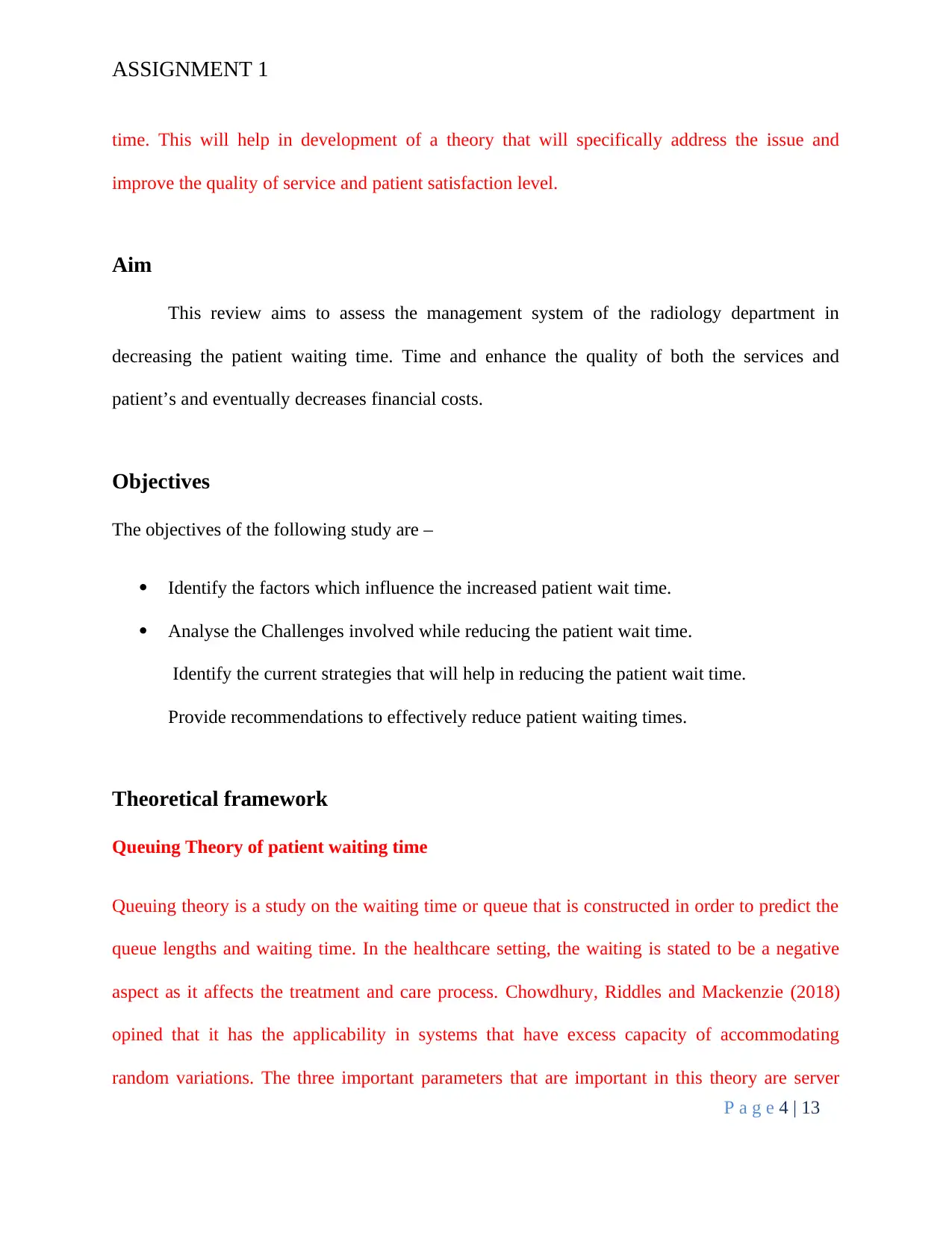
ASSIGNMENT 1
time. This will help in development of a theory that will specifically address the issue and
improve the quality of service and patient satisfaction level.
Aim
This review aims to assess the management system of the radiology department in
decreasing the patient waiting time. Time and enhance the quality of both the services and
patient’s and eventually decreases financial costs.
Objectives
The objectives of the following study are –
Identify the factors which influence the increased patient wait time.
Analyse the Challenges involved while reducing the patient wait time.
Identify the current strategies that will help in reducing the patient wait time.
Provide recommendations to effectively reduce patient waiting times.
Theoretical framework
Queuing Theory of patient waiting time
Queuing theory is a study on the waiting time or queue that is constructed in order to predict the
queue lengths and waiting time. In the healthcare setting, the waiting is stated to be a negative
aspect as it affects the treatment and care process. Chowdhury, Riddles and Mackenzie (2018)
opined that it has the applicability in systems that have excess capacity of accommodating
random variations. The three important parameters that are important in this theory are server
P a g e 4 | 13
time. This will help in development of a theory that will specifically address the issue and
improve the quality of service and patient satisfaction level.
Aim
This review aims to assess the management system of the radiology department in
decreasing the patient waiting time. Time and enhance the quality of both the services and
patient’s and eventually decreases financial costs.
Objectives
The objectives of the following study are –
Identify the factors which influence the increased patient wait time.
Analyse the Challenges involved while reducing the patient wait time.
Identify the current strategies that will help in reducing the patient wait time.
Provide recommendations to effectively reduce patient waiting times.
Theoretical framework
Queuing Theory of patient waiting time
Queuing theory is a study on the waiting time or queue that is constructed in order to predict the
queue lengths and waiting time. In the healthcare setting, the waiting is stated to be a negative
aspect as it affects the treatment and care process. Chowdhury, Riddles and Mackenzie (2018)
opined that it has the applicability in systems that have excess capacity of accommodating
random variations. The three important parameters that are important in this theory are server
P a g e 4 | 13
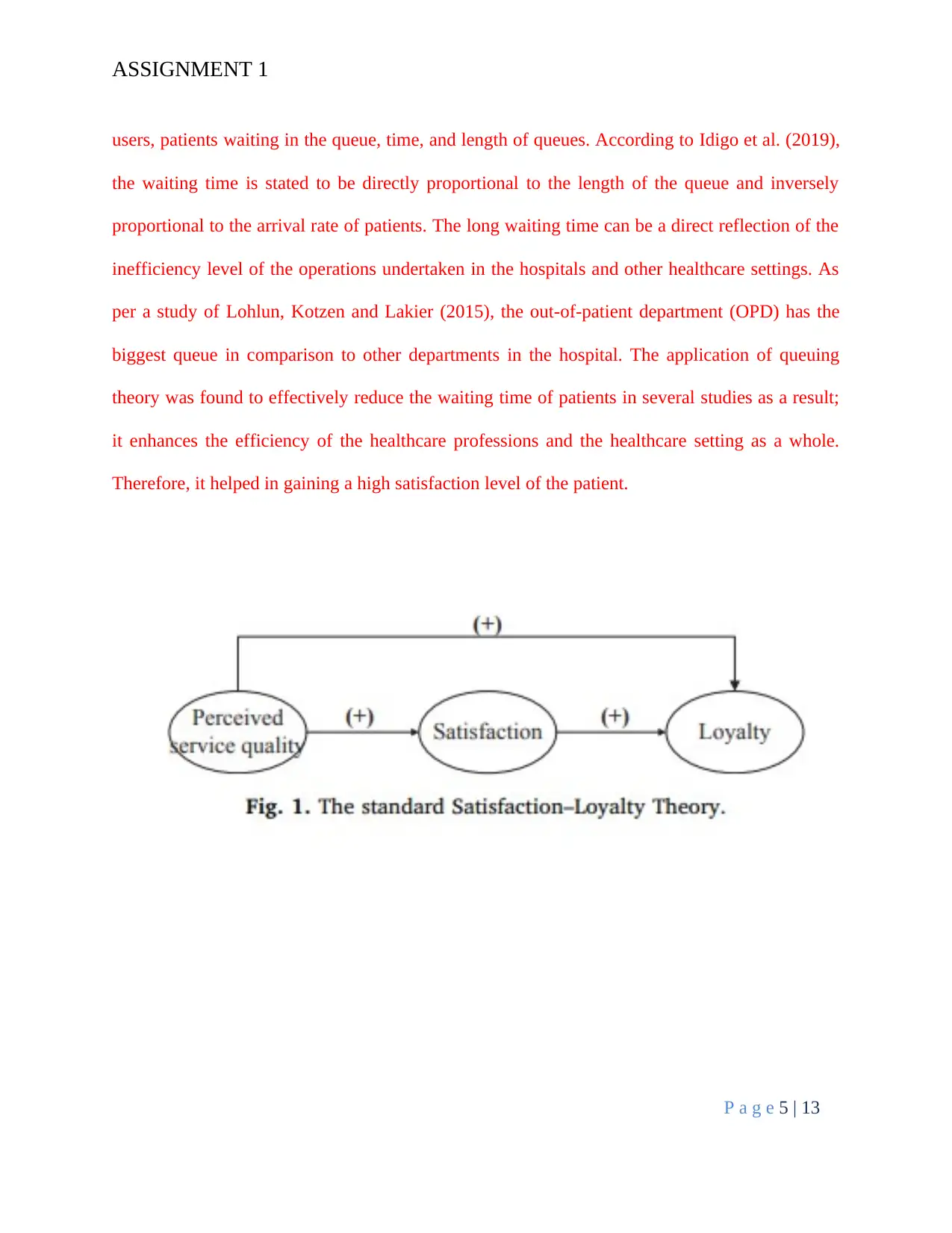
ASSIGNMENT 1
users, patients waiting in the queue, time, and length of queues. According to Idigo et al. (2019),
the waiting time is stated to be directly proportional to the length of the queue and inversely
proportional to the arrival rate of patients. The long waiting time can be a direct reflection of the
inefficiency level of the operations undertaken in the hospitals and other healthcare settings. As
per a study of Lohlun, Kotzen and Lakier (2015), the out-of-patient department (OPD) has the
biggest queue in comparison to other departments in the hospital. The application of queuing
theory was found to effectively reduce the waiting time of patients in several studies as a result;
it enhances the efficiency of the healthcare professions and the healthcare setting as a whole.
Therefore, it helped in gaining a high satisfaction level of the patient.
P a g e 5 | 13
users, patients waiting in the queue, time, and length of queues. According to Idigo et al. (2019),
the waiting time is stated to be directly proportional to the length of the queue and inversely
proportional to the arrival rate of patients. The long waiting time can be a direct reflection of the
inefficiency level of the operations undertaken in the hospitals and other healthcare settings. As
per a study of Lohlun, Kotzen and Lakier (2015), the out-of-patient department (OPD) has the
biggest queue in comparison to other departments in the hospital. The application of queuing
theory was found to effectively reduce the waiting time of patients in several studies as a result;
it enhances the efficiency of the healthcare professions and the healthcare setting as a whole.
Therefore, it helped in gaining a high satisfaction level of the patient.
P a g e 5 | 13
⊘ This is a preview!⊘
Do you want full access?
Subscribe today to unlock all pages.

Trusted by 1+ million students worldwide
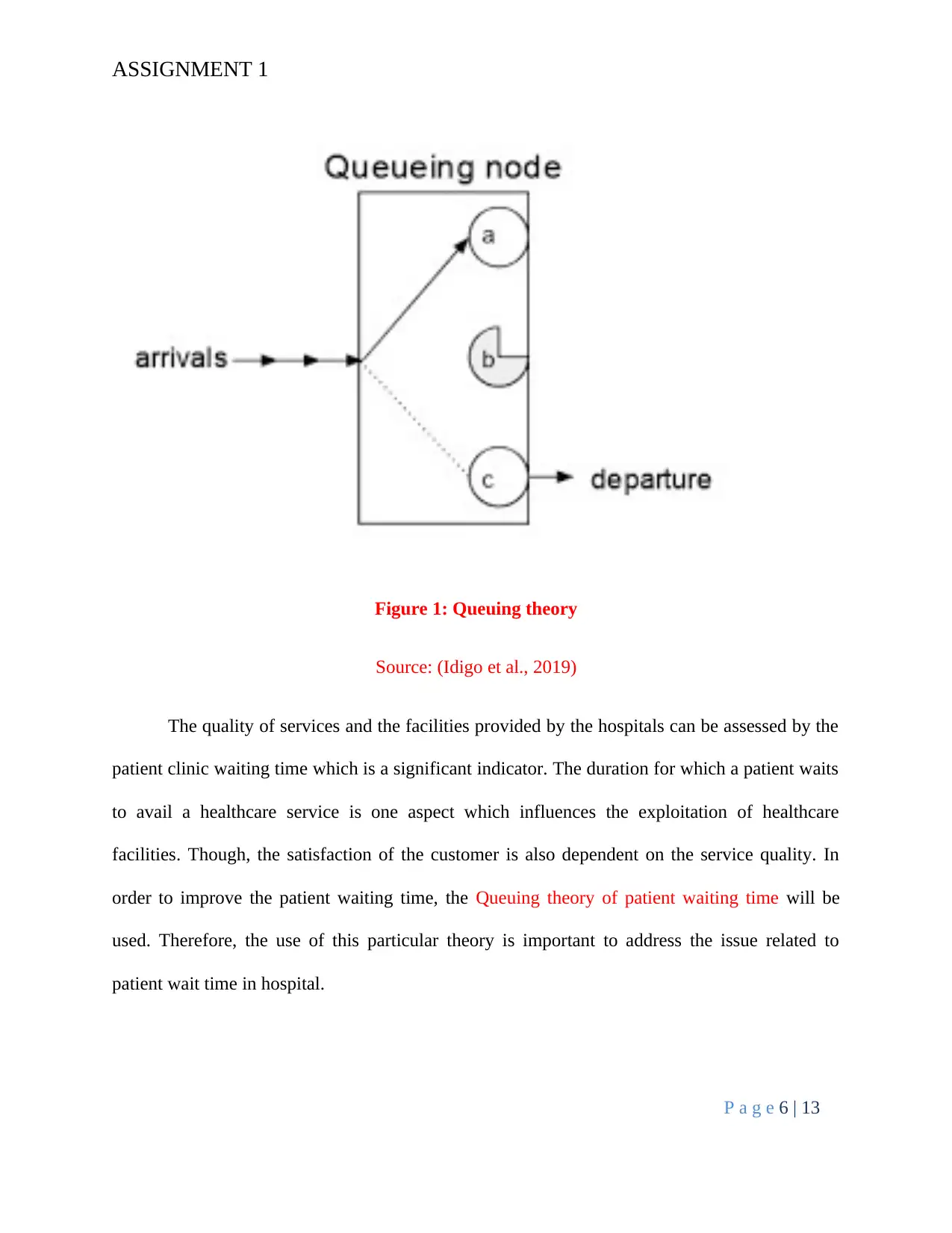
ASSIGNMENT 1
Figure 1: Queuing theory
Source: (Idigo et al., 2019)
The quality of services and the facilities provided by the hospitals can be assessed by the
patient clinic waiting time which is a significant indicator. The duration for which a patient waits
to avail a healthcare service is one aspect which influences the exploitation of healthcare
facilities. Though, the satisfaction of the customer is also dependent on the service quality. In
order to improve the patient waiting time, the Queuing theory of patient waiting time will be
used. Therefore, the use of this particular theory is important to address the issue related to
patient wait time in hospital.
P a g e 6 | 13
Figure 1: Queuing theory
Source: (Idigo et al., 2019)
The quality of services and the facilities provided by the hospitals can be assessed by the
patient clinic waiting time which is a significant indicator. The duration for which a patient waits
to avail a healthcare service is one aspect which influences the exploitation of healthcare
facilities. Though, the satisfaction of the customer is also dependent on the service quality. In
order to improve the patient waiting time, the Queuing theory of patient waiting time will be
used. Therefore, the use of this particular theory is important to address the issue related to
patient wait time in hospital.
P a g e 6 | 13
Paraphrase This Document
Need a fresh take? Get an instant paraphrase of this document with our AI Paraphraser
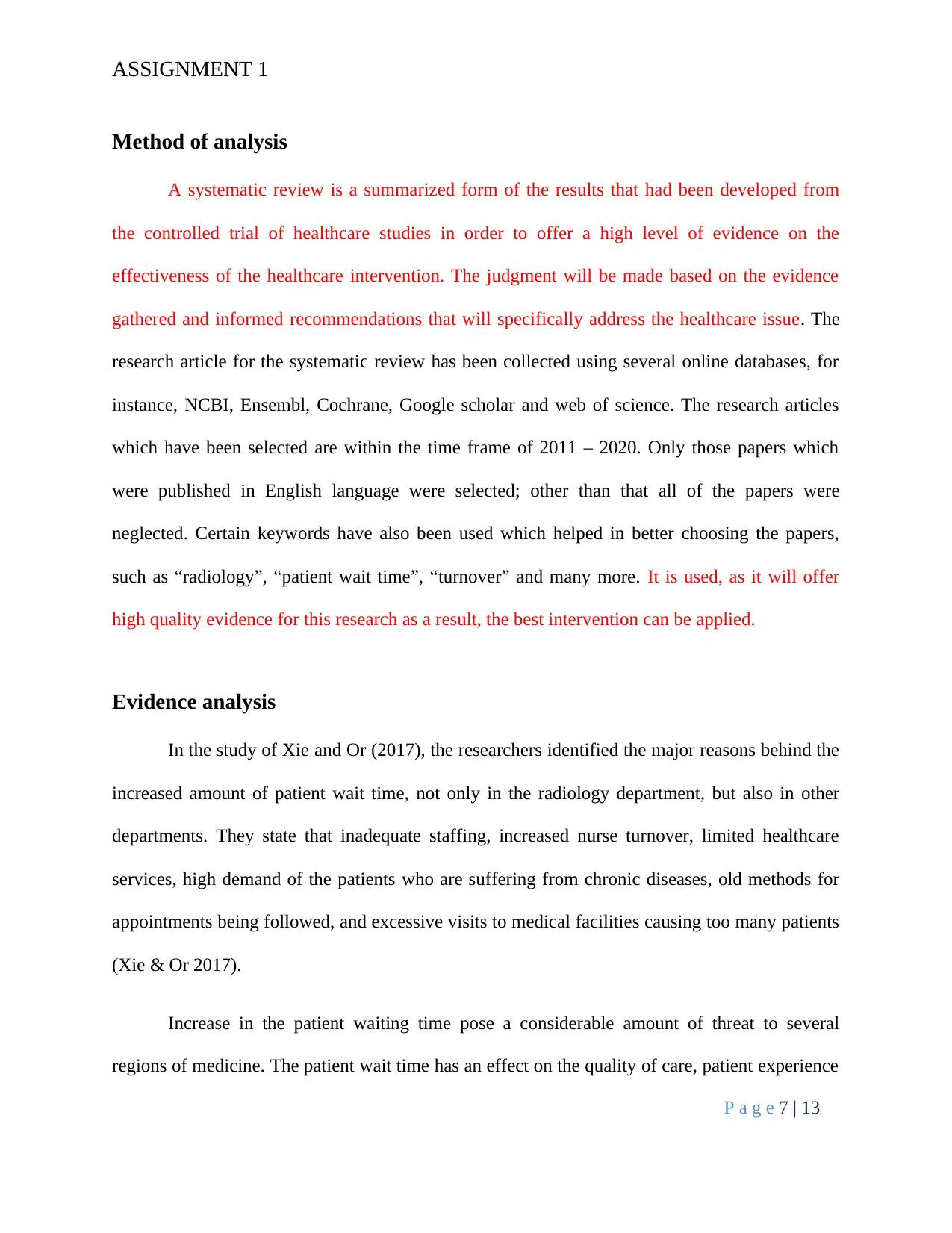
ASSIGNMENT 1
Method of analysis
A systematic review is a summarized form of the results that had been developed from
the controlled trial of healthcare studies in order to offer a high level of evidence on the
effectiveness of the healthcare intervention. The judgment will be made based on the evidence
gathered and informed recommendations that will specifically address the healthcare issue. The
research article for the systematic review has been collected using several online databases, for
instance, NCBI, Ensembl, Cochrane, Google scholar and web of science. The research articles
which have been selected are within the time frame of 2011 – 2020. Only those papers which
were published in English language were selected; other than that all of the papers were
neglected. Certain keywords have also been used which helped in better choosing the papers,
such as “radiology”, “patient wait time”, “turnover” and many more. It is used, as it will offer
high quality evidence for this research as a result, the best intervention can be applied.
Evidence analysis
In the study of Xie and Or (2017), the researchers identified the major reasons behind the
increased amount of patient wait time, not only in the radiology department, but also in other
departments. They state that inadequate staffing, increased nurse turnover, limited healthcare
services, high demand of the patients who are suffering from chronic diseases, old methods for
appointments being followed, and excessive visits to medical facilities causing too many patients
(Xie & Or 2017).
Increase in the patient waiting time pose a considerable amount of threat to several
regions of medicine. The patient wait time has an effect on the quality of care, patient experience
P a g e 7 | 13
Method of analysis
A systematic review is a summarized form of the results that had been developed from
the controlled trial of healthcare studies in order to offer a high level of evidence on the
effectiveness of the healthcare intervention. The judgment will be made based on the evidence
gathered and informed recommendations that will specifically address the healthcare issue. The
research article for the systematic review has been collected using several online databases, for
instance, NCBI, Ensembl, Cochrane, Google scholar and web of science. The research articles
which have been selected are within the time frame of 2011 – 2020. Only those papers which
were published in English language were selected; other than that all of the papers were
neglected. Certain keywords have also been used which helped in better choosing the papers,
such as “radiology”, “patient wait time”, “turnover” and many more. It is used, as it will offer
high quality evidence for this research as a result, the best intervention can be applied.
Evidence analysis
In the study of Xie and Or (2017), the researchers identified the major reasons behind the
increased amount of patient wait time, not only in the radiology department, but also in other
departments. They state that inadequate staffing, increased nurse turnover, limited healthcare
services, high demand of the patients who are suffering from chronic diseases, old methods for
appointments being followed, and excessive visits to medical facilities causing too many patients
(Xie & Or 2017).
Increase in the patient waiting time pose a considerable amount of threat to several
regions of medicine. The patient wait time has an effect on the quality of care, patient experience
P a g e 7 | 13
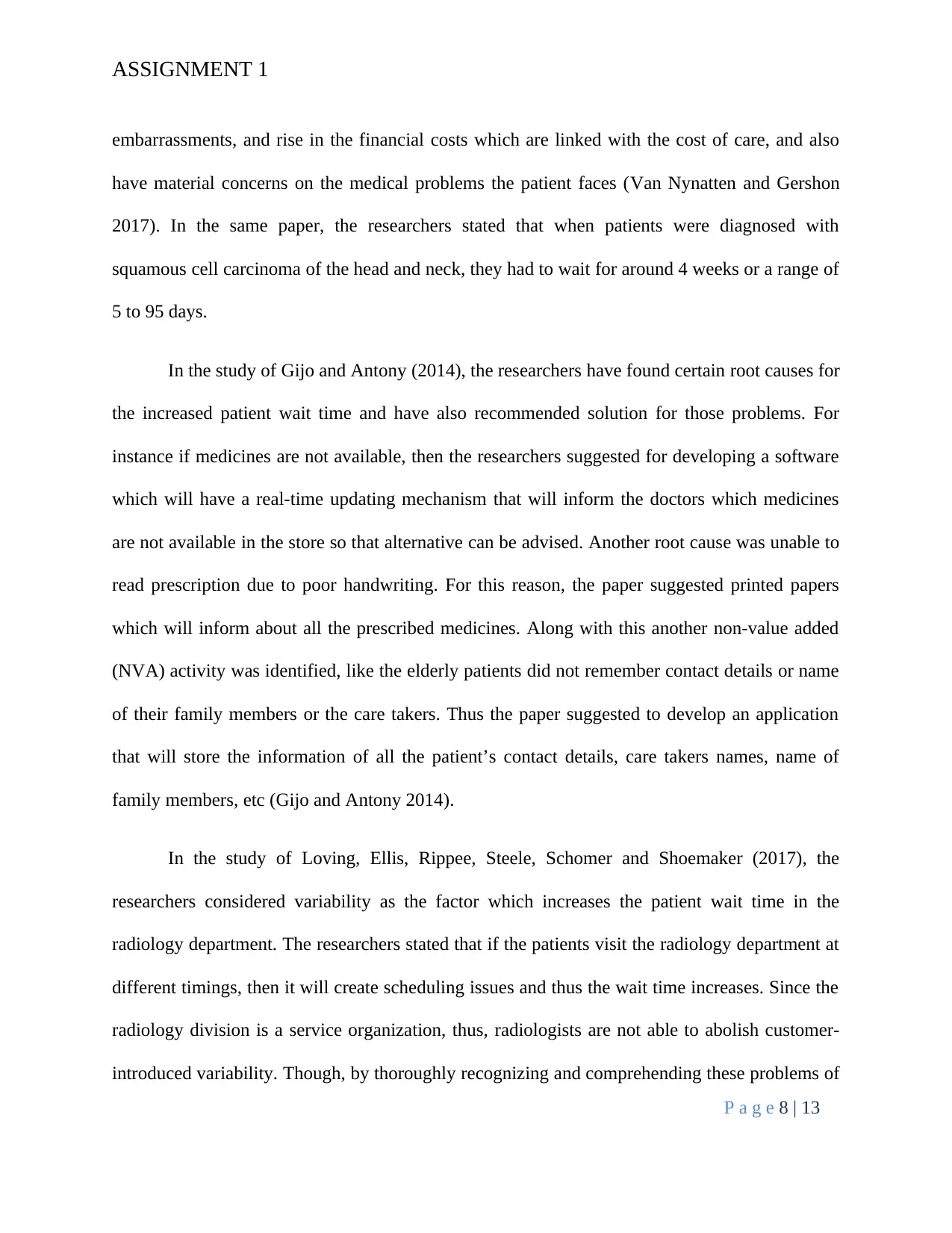
ASSIGNMENT 1
embarrassments, and rise in the financial costs which are linked with the cost of care, and also
have material concerns on the medical problems the patient faces (Van Nynatten and Gershon
2017). In the same paper, the researchers stated that when patients were diagnosed with
squamous cell carcinoma of the head and neck, they had to wait for around 4 weeks or a range of
5 to 95 days.
In the study of Gijo and Antony (2014), the researchers have found certain root causes for
the increased patient wait time and have also recommended solution for those problems. For
instance if medicines are not available, then the researchers suggested for developing a software
which will have a real-time updating mechanism that will inform the doctors which medicines
are not available in the store so that alternative can be advised. Another root cause was unable to
read prescription due to poor handwriting. For this reason, the paper suggested printed papers
which will inform about all the prescribed medicines. Along with this another non-value added
(NVA) activity was identified, like the elderly patients did not remember contact details or name
of their family members or the care takers. Thus the paper suggested to develop an application
that will store the information of all the patient’s contact details, care takers names, name of
family members, etc (Gijo and Antony 2014).
In the study of Loving, Ellis, Rippee, Steele, Schomer and Shoemaker (2017), the
researchers considered variability as the factor which increases the patient wait time in the
radiology department. The researchers stated that if the patients visit the radiology department at
different timings, then it will create scheduling issues and thus the wait time increases. Since the
radiology division is a service organization, thus, radiologists are not able to abolish customer-
introduced variability. Though, by thoroughly recognizing and comprehending these problems of
P a g e 8 | 13
embarrassments, and rise in the financial costs which are linked with the cost of care, and also
have material concerns on the medical problems the patient faces (Van Nynatten and Gershon
2017). In the same paper, the researchers stated that when patients were diagnosed with
squamous cell carcinoma of the head and neck, they had to wait for around 4 weeks or a range of
5 to 95 days.
In the study of Gijo and Antony (2014), the researchers have found certain root causes for
the increased patient wait time and have also recommended solution for those problems. For
instance if medicines are not available, then the researchers suggested for developing a software
which will have a real-time updating mechanism that will inform the doctors which medicines
are not available in the store so that alternative can be advised. Another root cause was unable to
read prescription due to poor handwriting. For this reason, the paper suggested printed papers
which will inform about all the prescribed medicines. Along with this another non-value added
(NVA) activity was identified, like the elderly patients did not remember contact details or name
of their family members or the care takers. Thus the paper suggested to develop an application
that will store the information of all the patient’s contact details, care takers names, name of
family members, etc (Gijo and Antony 2014).
In the study of Loving, Ellis, Rippee, Steele, Schomer and Shoemaker (2017), the
researchers considered variability as the factor which increases the patient wait time in the
radiology department. The researchers stated that if the patients visit the radiology department at
different timings, then it will create scheduling issues and thus the wait time increases. Since the
radiology division is a service organization, thus, radiologists are not able to abolish customer-
introduced variability. Though, by thoroughly recognizing and comprehending these problems of
P a g e 8 | 13
⊘ This is a preview!⊘
Do you want full access?
Subscribe today to unlock all pages.

Trusted by 1+ million students worldwide
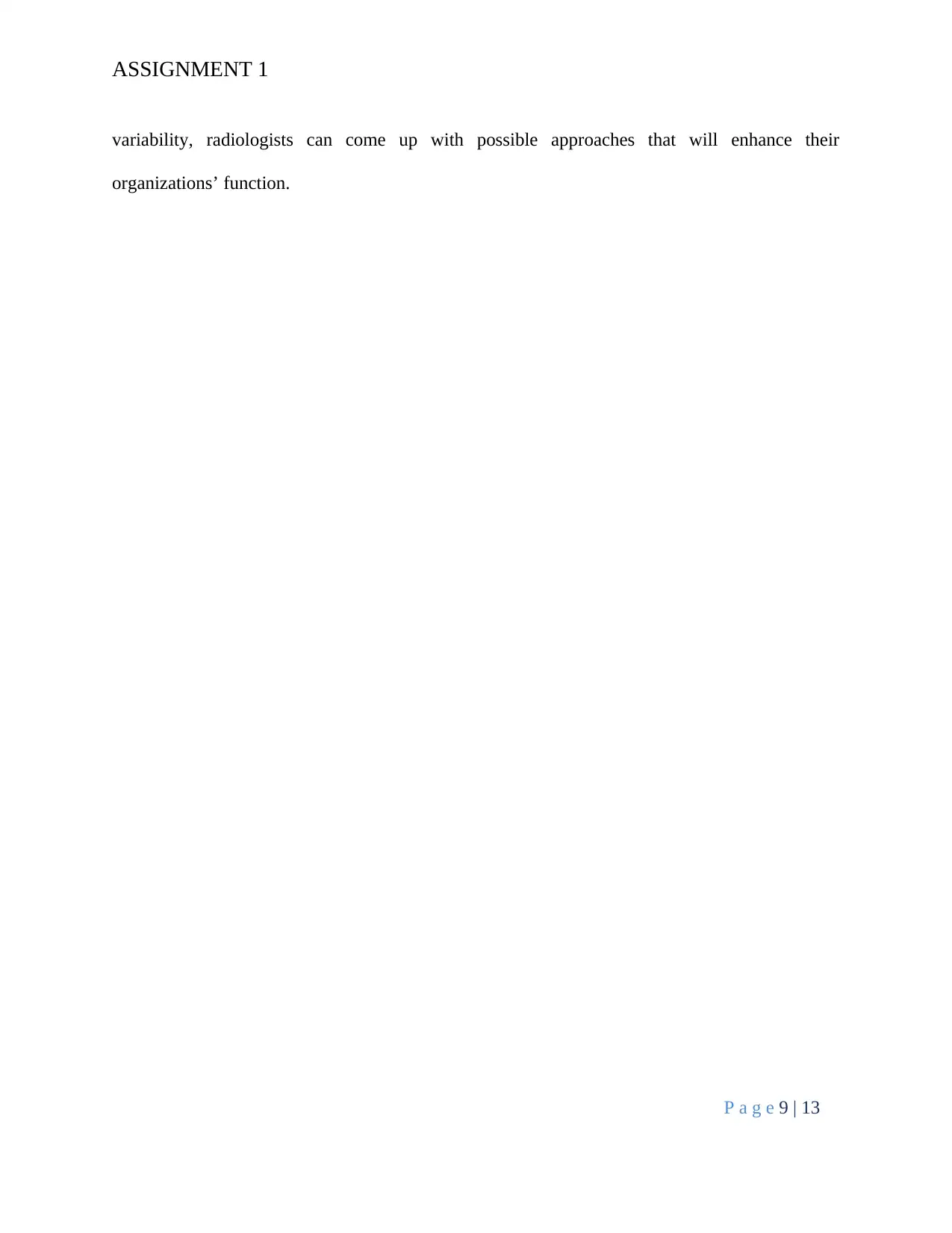
ASSIGNMENT 1
variability, radiologists can come up with possible approaches that will enhance their
organizations’ function.
P a g e 9 | 13
variability, radiologists can come up with possible approaches that will enhance their
organizations’ function.
P a g e 9 | 13
Paraphrase This Document
Need a fresh take? Get an instant paraphrase of this document with our AI Paraphraser
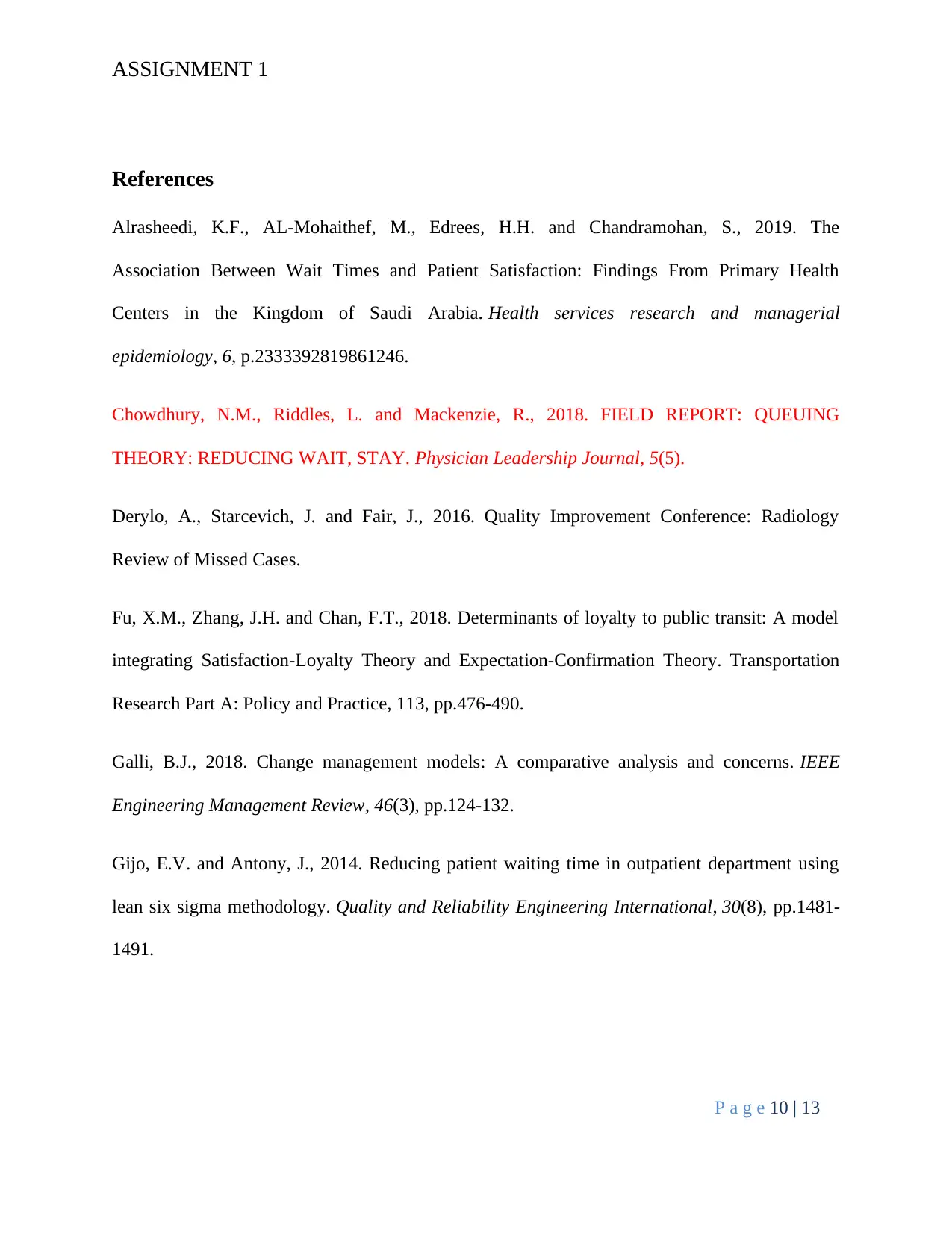
ASSIGNMENT 1
References
Alrasheedi, K.F., AL-Mohaithef, M., Edrees, H.H. and Chandramohan, S., 2019. The
Association Between Wait Times and Patient Satisfaction: Findings From Primary Health
Centers in the Kingdom of Saudi Arabia. Health services research and managerial
epidemiology, 6, p.2333392819861246.
Chowdhury, N.M., Riddles, L. and Mackenzie, R., 2018. FIELD REPORT: QUEUING
THEORY: REDUCING WAIT, STAY. Physician Leadership Journal, 5(5).
Derylo, A., Starcevich, J. and Fair, J., 2016. Quality Improvement Conference: Radiology
Review of Missed Cases.
Fu, X.M., Zhang, J.H. and Chan, F.T., 2018. Determinants of loyalty to public transit: A model
integrating Satisfaction-Loyalty Theory and Expectation-Confirmation Theory. Transportation
Research Part A: Policy and Practice, 113, pp.476-490.
Galli, B.J., 2018. Change management models: A comparative analysis and concerns. IEEE
Engineering Management Review, 46(3), pp.124-132.
Gijo, E.V. and Antony, J., 2014. Reducing patient waiting time in outpatient department using
lean six sigma methodology. Quality and Reliability Engineering International, 30(8), pp.1481-
1491.
P a g e 10 | 13
References
Alrasheedi, K.F., AL-Mohaithef, M., Edrees, H.H. and Chandramohan, S., 2019. The
Association Between Wait Times and Patient Satisfaction: Findings From Primary Health
Centers in the Kingdom of Saudi Arabia. Health services research and managerial
epidemiology, 6, p.2333392819861246.
Chowdhury, N.M., Riddles, L. and Mackenzie, R., 2018. FIELD REPORT: QUEUING
THEORY: REDUCING WAIT, STAY. Physician Leadership Journal, 5(5).
Derylo, A., Starcevich, J. and Fair, J., 2016. Quality Improvement Conference: Radiology
Review of Missed Cases.
Fu, X.M., Zhang, J.H. and Chan, F.T., 2018. Determinants of loyalty to public transit: A model
integrating Satisfaction-Loyalty Theory and Expectation-Confirmation Theory. Transportation
Research Part A: Policy and Practice, 113, pp.476-490.
Galli, B.J., 2018. Change management models: A comparative analysis and concerns. IEEE
Engineering Management Review, 46(3), pp.124-132.
Gijo, E.V. and Antony, J., 2014. Reducing patient waiting time in outpatient department using
lean six sigma methodology. Quality and Reliability Engineering International, 30(8), pp.1481-
1491.
P a g e 10 | 13
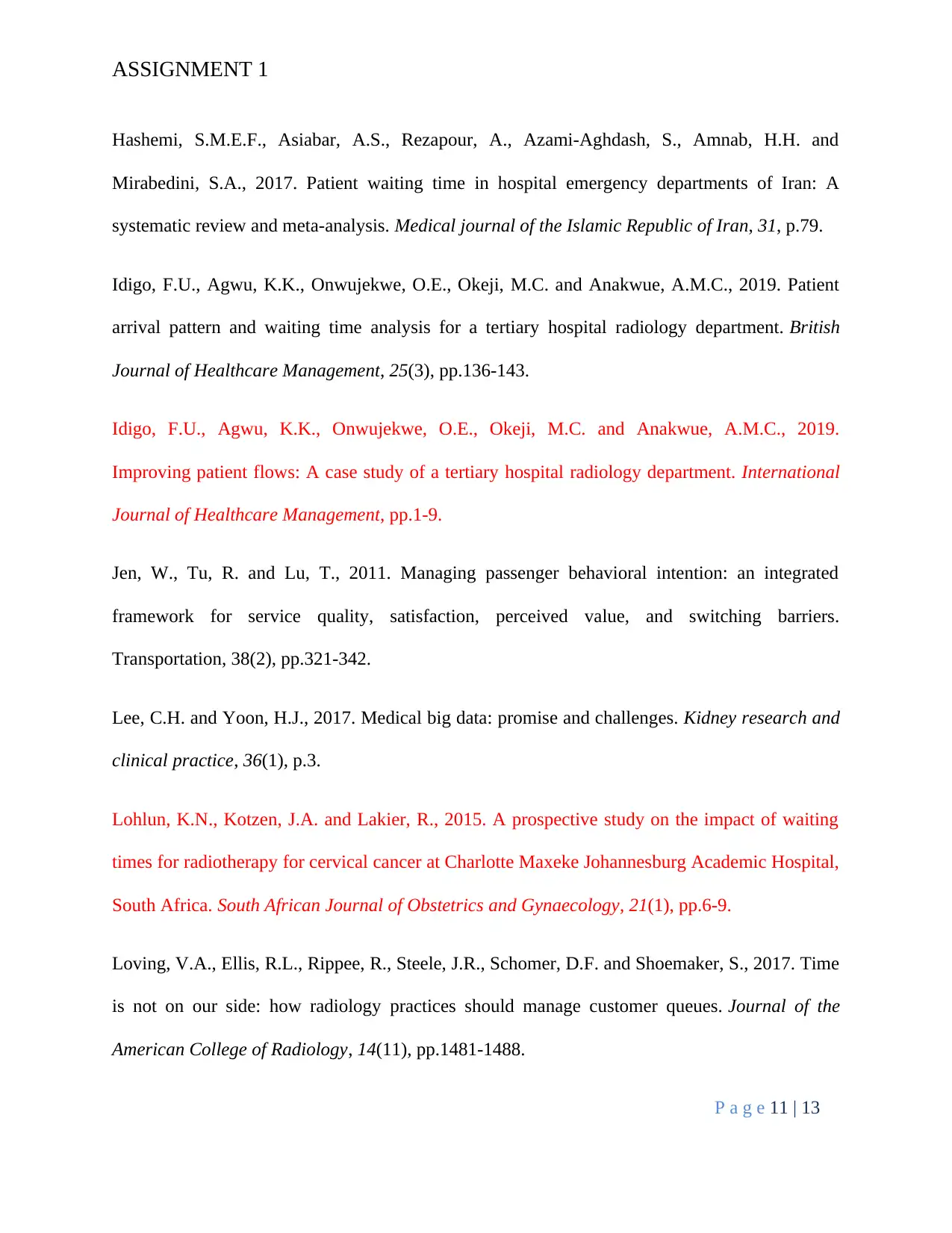
ASSIGNMENT 1
Hashemi, S.M.E.F., Asiabar, A.S., Rezapour, A., Azami-Aghdash, S., Amnab, H.H. and
Mirabedini, S.A., 2017. Patient waiting time in hospital emergency departments of Iran: A
systematic review and meta-analysis. Medical journal of the Islamic Republic of Iran, 31, p.79.
Idigo, F.U., Agwu, K.K., Onwujekwe, O.E., Okeji, M.C. and Anakwue, A.M.C., 2019. Patient
arrival pattern and waiting time analysis for a tertiary hospital radiology department. British
Journal of Healthcare Management, 25(3), pp.136-143.
Idigo, F.U., Agwu, K.K., Onwujekwe, O.E., Okeji, M.C. and Anakwue, A.M.C., 2019.
Improving patient flows: A case study of a tertiary hospital radiology department. International
Journal of Healthcare Management, pp.1-9.
Jen, W., Tu, R. and Lu, T., 2011. Managing passenger behavioral intention: an integrated
framework for service quality, satisfaction, perceived value, and switching barriers.
Transportation, 38(2), pp.321-342.
Lee, C.H. and Yoon, H.J., 2017. Medical big data: promise and challenges. Kidney research and
clinical practice, 36(1), p.3.
Lohlun, K.N., Kotzen, J.A. and Lakier, R., 2015. A prospective study on the impact of waiting
times for radiotherapy for cervical cancer at Charlotte Maxeke Johannesburg Academic Hospital,
South Africa. South African Journal of Obstetrics and Gynaecology, 21(1), pp.6-9.
Loving, V.A., Ellis, R.L., Rippee, R., Steele, J.R., Schomer, D.F. and Shoemaker, S., 2017. Time
is not on our side: how radiology practices should manage customer queues. Journal of the
American College of Radiology, 14(11), pp.1481-1488.
P a g e 11 | 13
Hashemi, S.M.E.F., Asiabar, A.S., Rezapour, A., Azami-Aghdash, S., Amnab, H.H. and
Mirabedini, S.A., 2017. Patient waiting time in hospital emergency departments of Iran: A
systematic review and meta-analysis. Medical journal of the Islamic Republic of Iran, 31, p.79.
Idigo, F.U., Agwu, K.K., Onwujekwe, O.E., Okeji, M.C. and Anakwue, A.M.C., 2019. Patient
arrival pattern and waiting time analysis for a tertiary hospital radiology department. British
Journal of Healthcare Management, 25(3), pp.136-143.
Idigo, F.U., Agwu, K.K., Onwujekwe, O.E., Okeji, M.C. and Anakwue, A.M.C., 2019.
Improving patient flows: A case study of a tertiary hospital radiology department. International
Journal of Healthcare Management, pp.1-9.
Jen, W., Tu, R. and Lu, T., 2011. Managing passenger behavioral intention: an integrated
framework for service quality, satisfaction, perceived value, and switching barriers.
Transportation, 38(2), pp.321-342.
Lee, C.H. and Yoon, H.J., 2017. Medical big data: promise and challenges. Kidney research and
clinical practice, 36(1), p.3.
Lohlun, K.N., Kotzen, J.A. and Lakier, R., 2015. A prospective study on the impact of waiting
times for radiotherapy for cervical cancer at Charlotte Maxeke Johannesburg Academic Hospital,
South Africa. South African Journal of Obstetrics and Gynaecology, 21(1), pp.6-9.
Loving, V.A., Ellis, R.L., Rippee, R., Steele, J.R., Schomer, D.F. and Shoemaker, S., 2017. Time
is not on our side: how radiology practices should manage customer queues. Journal of the
American College of Radiology, 14(11), pp.1481-1488.
P a g e 11 | 13
⊘ This is a preview!⊘
Do you want full access?
Subscribe today to unlock all pages.

Trusted by 1+ million students worldwide
1 out of 13
Related Documents
Your All-in-One AI-Powered Toolkit for Academic Success.
+13062052269
info@desklib.com
Available 24*7 on WhatsApp / Email
![[object Object]](/_next/static/media/star-bottom.7253800d.svg)
Unlock your academic potential
Copyright © 2020–2025 A2Z Services. All Rights Reserved. Developed and managed by ZUCOL.





